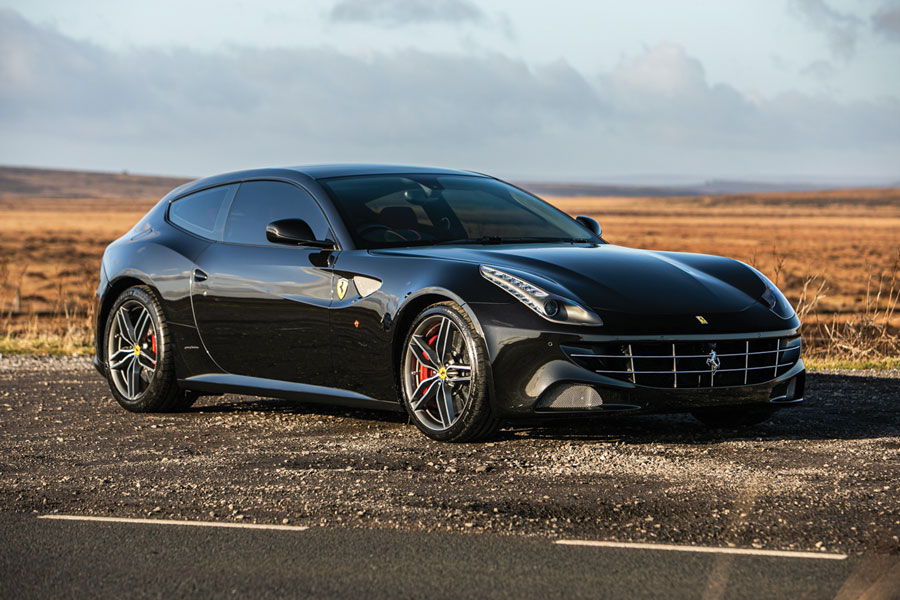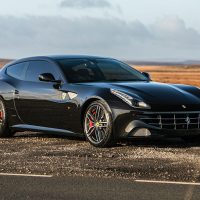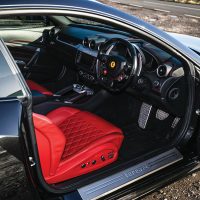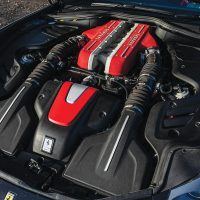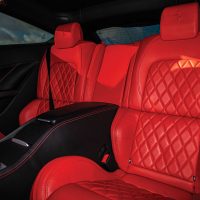SCM Analysis
Detailing
| Vehicle: | 2012 Ferrari FF |
| Years Produced: | 2011–16 |
| Number Produced: | 2,800 (estimate) |
| Original List Price: | $300,000 plus an average of about $45,000 in options |
| SCM Valuation: | N/A |
| Chassis Number Location: | Door jamb |
| Engine Number Location: | Rear passenger’s side of block |
| Club Info: | Ferrari Club of America |
| Website: | http://www.FerrariClubofAmerica.org |
| Alternatives: | 2012 Aston Martin Rapide, 2014 Rolls-Royce Wraith, 2012 Mercedes-Benz CL63 AMG |
| Investment Grade: | C |
This car, Lot 463, sold for $103,309, including buyer’s premium, at Silverstone’s Race Retro auction in Northhamptonshire, U.K., on February 22, 2020.
There is an elephant in the room. The hatchback, shooting brake, station wagon, or whatever you want to call it, Ferrari FF, is the most polarizing design of any Ferrari that I can recall.
People either love it or hate it. Some find it sacrilegious for Ferrari to deviate from hardcore sports cars, while others relish the idea of having a Ferrari that will hold a mountain bike or a couple sets of golf clubs.
Not knowing exactly how to describe the car, I checked out Ferrari.com to see how they described the rear styling of the FF. Surprisingly, the elephant is ignored.
Ferrari offers that FF means four-seat, four-wheel drive. They celebrate Pininfarina’s blending of Ferrari’s traditional “signature” with a “modern, innovative,” and “futuristic” theme. Ferrari goes to great lengths to describe the FF’s aerodynamic and cooling airflow, but there is not one sentence about the most controversial aspect of the FF — the compromise of aesthetics for practicality.
My first exposure to a Ferrari FF was at a local Ferrari dealer’s introduction party. I had previously seen pictures of the car and found it perplexing.
The car was attractive, and I appreciated what Ferrari was trying to do, but I was not entirely comfortable with Ferrari’s direction. I had watched Porsche’s identity change as they moved towards becoming a mainstream car company, and Ferrari leaning even slightly in that direction was not a door I wanted opened.
That said, I am a sucker for hatches and sports wagons. I’ve long lusted after a Volvo 1800ES Sports Wagon and admire Alfa’s Brera, Audi’s RS6, and Mercedes’ AMG wagons. I even owned a wagonish Type 75 Lotus Elite.
I like the irony of adding a utilitarian twist to a sporty car or adding a sporty twist to an otherwise utilitarian vehicle.
The rear seats are… comfortable
I am also a sucker for interesting interiors. The FF is designed to be a GT car, and it feels spacious. Ferrari intended the rear seats to be used. They are individual buckets that look as purposeful as the front seats. There is plenty of side and knee room for an adult to comfortably ride in the rear. The hatchback roofline gives rear passengers enough headroom to sit comfortably without compromise.
The days of sparse Ferrari interiors ended several generations ago, and the FF’s interior proves the point. The FF’s interior is exquisitely detailed and sumptuously appointed with the finest materials. If a surface is not carbon or covered in Alcantara, it is most likely covered in rich leather. Look up, look down, look left, look right, everywhere you look there’s beautiful leather.
Ferrari’s endless option list allows — make that encourages — personalization on a level that is perhaps unmatched in the performance-car field. Carbon interior trim is available for numerous surfaces, and the upholstery options nearly guarantee the ability to create a unique example.
The FF’s electronic wizardry is up to luxury-car standards, with multiple infotainment screens. There is even a passenger’s side speedometer option. Special-order builds are only limited by imagination and budget.
Yes, it moves on out
As intoxicating as the interior may be, the FF is a Ferrari, after all, and it is what goes on when you hit the gas that makes a Ferrari a Ferrari.
The FF’s power comes from a derivative of an Enzo supercar engine. The FF’s 6.3-liter engine is rated at 660 horsepower, which is the same as the Enzo — except the FF’s rating is at a screaming 8,000 rpm rather than the Enzo’s tamer 7,800.
Power is transmitted to the rear wheels through a dual-clutch, super-fast, 7-speed, F1 gearbox. The front wheels are tied to a 2-speed gearbox. Strange as it sounds, the pairing works well. Acceleration to 62 mph bests the 288 GTO, F40, F50 — and happens a scant half second slower than the Enzo.
A daily driver!
I cannot stress enough that owners love their FFs. Many owners use them as everyday cars. They take them to work, to the store, on skiing trips — or just as an excuse to not go home. I know a gentleman who had two at a time, and I know people who are on their second or third one.
A Ferrari Chat post puts it best: “I love mine. Could gush about it for days. Not saving it for the next guy. And every time the back end tries to come out when I am driving in the snow and it snaps back, I literally smile and think, what an awesome car.”
Our subject Ferrari FF
Silverstone’s FF was an early-production 2012 model. It was reported to have a documented 37,800 miles. It was a right-hand-drive car that was selling in a right-hand-drive market. The black livery was attractively complemented with quilted red leather sports seats.
The car was well equipped, but it lacked any of the expensive carbon accents buyers like to see.
A $103,000 auction price is a huge drop from a $350,000 MSRP, but that’s normal depreciation for a luxury coupe.
FFs appeal to a buyer who wants to drive one every day for a couple of years — and then trade out for another car.
FF buyers are more concerned with lease payments than depreciation. A different Ferrari Chatter whose wife drives an FF was asked about cost per mile. His reply: “Cost per mile of happy wife… priceless.”
A survey of the U.K. FF market found several offered at a little more money than the Silverstone car. A little arm-twisting should get one at a similar price.
It is reasonable to expect the prices to drop more as the age and mileage of FFs increases. The big depreciation is over, though, and that’s good news for you. Grab one for your stable — you will be glad you did. ♦
(Introductory description courtesy of Silverstone Auctions.)
